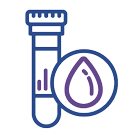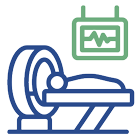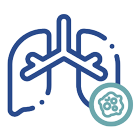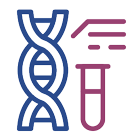What kind of tests are there for lung cancer?
Tests that you may have include:

Checking your medical records
Your doctor will check your medical records and will ask you questions about the medical history of you and your close family members (blood relatives including parents, grandparents and siblings). They may ask you about:
- Symptoms that may be related to lung cancer and any other health problems.
- Risk factors, such as exposure to tobacco smoke or asbestos, and other diseases that are linked to lung cancer
- Whether you use tobacco or have used it in the past, and how much tobacco you use(d) per day.
- The medical history of close relatives because some cancers can be linked to mutations (changes in genes) that can be inherited (passed on from one generation of a family to another).
- Any treatments or medications that you have had in the past or are receiving now.

Physical examination
As well as looking for signs and symptoms of lung cancer, your doctor may:
- Measure your temperature, weight, blood pressure and pulse.
- Measure your breathing rate and listen to any noise made when the air goes into and out of your lungs as you breathe.
- Examine your nose, mouth, eyes, ears and skin, and listen to your lungs, heart and gut.
- Check how easily you can do day-to-day activities.

Blood tests
Blood tests are done in a laboratory on samples of blood. A medical professional will take the blood sample from a vein (a type of blood vessel), usually in your arm, using a syringe. The sample will then be sent off to the laboratory for analysis. It may take 1–2 weeks for you to get the results. Blood tests usually involve:
- Assessing complete blood count (CBC), which looks at the numbers of different cell types in the blood. If the number of a type of cell is higher or lower than normal it can indicate that a person has a disease.
- A biochemistry profile, which is used to assess how well the kidneys, liver, bone and other organs are working. If the level of a certain molecule is higher or lower than normal it can indicate that an organ isn’t working properly.

Imaging tests
Imaging tests take images (pictures) of the inside of the body. Some involve ‘having a scan’. A specialist doctor called a radiologist will conduct the imaging test and assess the results.
- X-rays: High-energy X-rays are used to take pictures, which can help diagnose lung cancer and show whether it has spread to other areas of the body.
- CT scan: CT stands for ‘computed tomography’. This type of scan uses a computer to combine pictures taken with X-rays to form detailed images. It can be used to diagnose and stage lung cancer, monitor it over time, and guide further tests and treatments.
- PET scan: PET stands for ‘positron emission tomography’. This type of scan creates a sensitive, 3-dimensional (3D) image that can detect small changes in the body, such as how far a cancer has spread and whether it is responding to treatment. PET scans are usually done after someone has received a lung cancer diagnosis.
- MRI scan: MRI stands for ‘magnetic resonance imaging’. This type of scan builds an detailed images using strong magnetic fields and radio waves. It is used to check where else in the body a lung cancer has spread to.

Tissue samples
This type of text involves a sample of tissue or cells being analysed in a laboratory and can help determine the type of lung cancer you have. The sample can be obtained by biopsy or cytology.
- Biopsy involves a small amount of tissue being taken from the lungs. Biopsy samples can be taken during a bronchoscopy (a test that looks at the inside of the airways or your lungs), by passing a fine needle through the skin and into the lung (this is called a percutaneous biopsy), or during either keyhole or open surgery.
- Cytology involves a sample of fluid being checked for the presence of cancer cells. The sample may be fluid taken from inside the body using a fine needle (fine-needle aspiration) or be sputum (mucus, also called phlegm) that has been coughed up.

Biomarker tests
Biomarker tests are only done for specific types of lung cancer. The term ‘biomarker’ is short for biological marker. Biomarkers are measurable characteristics that can indicate what is going on in the body. Lung cancer biomarkers can indicate that lung cancer is present, and can also be used to assess how a lung cancer is progressing and the effects of treatments.
Your blood pressure, changes in your genes (DNA), and levels of molecules in your urine and blood are all biomarkers. Biomarkers that are important in lung cancer can be split into 3 groups.
- Histological biomarkers help determine the type of lung cancer you have, and are assessed by examining samples of cells or tissues with a microscope.
- Molecular biomarkers include genes, proteins and other molecules, and may affect how cancer cells grow, multiply and/or respond to treatment.
- Immunological biomarkers include molecules involved in the body’s immune system and molecules that cancer cells use to avoid being detected and removed by it.
How can lung cancer biomarkers be used?
Lung cancer biomarkers can be used in different ways:







